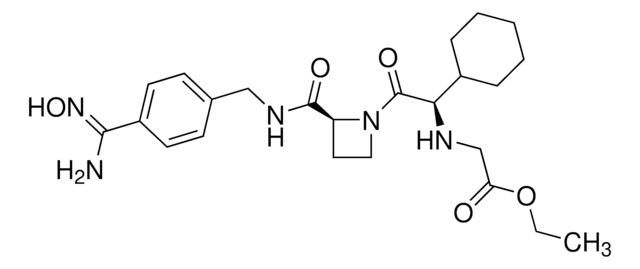Z101
Zimelidine dihydrochloride
solid
Sinónimos:
(Z)-3-(4-Bromophenyl)-N,N-dimethyl-3-(3-pyridinyl)-2-propen-1-amine dihydrochloride
About This Item
Productos recomendados
Formulario
solid
color
white
solubilidad
0.1 M HCl: 45 mg/mL
H2O: 66 mg/mL
emisor
AstraZeneca
cadena SMILES
Cl[H].Cl[H].[H]\C(CN(C)C)=C(/c1ccc(Br)cc1)c2cccnc2
InChI
1S/C16H17BrN2.2ClH/c1-19(2)11-9-16(14-4-3-10-18-12-14)13-5-7-15(17)8-6-13;;/h3-10,12H,11H2,1-2H3;2*1H/b16-9-;;
Clave InChI
CXGURXWCQYHDIR-ULPVBNQHSA-N
Información sobre el gen
human ... HTR1A(3350) , HTR1B(3351) , HTR1D(3352) , HTR1E(3354) , HTR1F(3355) , HTR2A(3356) , HTR2B(3357) , HTR2C(3358) , HTR3A(3359) , HTR3B(9177) , HTR3C(170572) , HTR3D(200909) , HTR3E(285242) , HTR4(3360) , HTR5A(3361) , HTR5B(645694) , HTR6(3362) , HTR7(3363)
Aplicación
Acciones bioquímicas o fisiológicas
Características y beneficios
Información legal
Palabra de señalización
Warning
Frases de peligro
Consejos de prudencia
Clasificaciones de peligro
Acute Tox. 4 Oral
Código de clase de almacenamiento
11 - Combustible Solids
Clase de riesgo para el agua (WGK)
WGK 3
Punto de inflamabilidad (°F)
Not applicable
Punto de inflamabilidad (°C)
Not applicable
Equipo de protección personal
dust mask type N95 (US), Eyeshields, Gloves
Elija entre una de las versiones más recientes:
¿Ya tiene este producto?
Encuentre la documentación para los productos que ha comprado recientemente en la Biblioteca de documentos.
Nuestro equipo de científicos tiene experiencia en todas las áreas de investigación: Ciencias de la vida, Ciencia de los materiales, Síntesis química, Cromatografía, Analítica y muchas otras.
Póngase en contacto con el Servicio técnico








